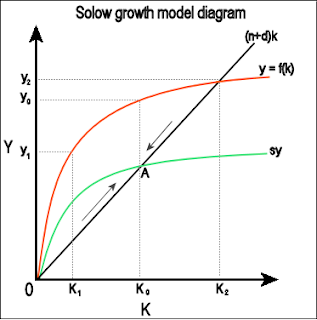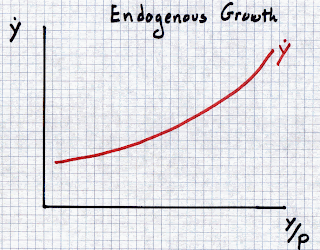Freakanomoics and Church
By no means am I going to sit here and tell you that I know how to think like an economist and craft interesting arguments about real life situations using economic tools. I did however run into a little book entitled: 30 Second Economics: The 50 most thought-provoking economics theories, each explained in half a minute and it got me thinking.
There is a mindset in many of my clergy peers that I have never gotten on board with because I just do not understand it. The idea is this:
If you want a church to grow, you just need to get more people to join.
After looking at this little book for a while I believe this mantra of growth in a church (more members means more growth) is what is called a Neoclassical growth theory. Not to get too heady here but this theory states that there are three things that drive growth which I parenthetically translate in "church-speak" - capital (money), labor (people), technology (ministries).
This theory states that if you have money and labor that adapts to technological changes then you have growth. And it works, but the main driver of growth is technology (ministries). We can build all the church buildings we want to, but eventually the "market" for church buildings will run dry and only until there is a technological change in the way church "is done" that growth happens.
We can see this in the mega church movement. These communities changed the way the did ministries and that leads to a whole new growth. It was the same of the "emergent church" and the "neo-monastic" movements. New ways of doing ministry lead to growth.
 The problem that I see is that many of those who feel the way to grow a church is to get more members are correct to a point. As you can see in the image to the right, growth in the neoclassical theory has diminishing returns over time and rises quickly then slowly grows (see the red line).
The problem that I see is that many of those who feel the way to grow a church is to get more members are correct to a point. As you can see in the image to the right, growth in the neoclassical theory has diminishing returns over time and rises quickly then slowly grows (see the red line).
The real way to drive growth is through technology, or a better word would be innovation.
For ages we have waited for different innovative technologies/ministries to come into existence and then the church co-opts them. Take the whole "Christian music" industry. It is just "regular music" but with Jesus lyrics. We co-oped it.
But the Christian music "innovation" was something that came from outside the church and the church took it on. This innovative way to connect with people was something that the church did not think of but uses often in worship. The church waits for innovate technologies/ministries to crop up and then we co-op them.
If innovation drives growth (as per the Neoclassical growth model argues) then the church must stop focusing on people and money and focus on innovation. When we do then growth patterns look differently (see this red line that maps out endogenous or New growth theory)
Apple could stop making new Ipads and soon enough their growth will stop, because everyone has one.
Google could stop creating things like "docs" and soon enough their growth will stop, because we have many ways to share files.
Facebook could stop creating new ways to connect people and soon enough their growth will stop, because there are many looking to be like FB.
Innovation is the key to growth, even (especially) growth in a church. Look at the innovation in the message of Jesus and Paul!
I am calling on all church leaders to being to shift the way we look at growth and stop focusing on just "getting more people". Rather, we need to adopt "New Growth Theory" and innovate from within. This means we need to stop waiting for innovation to happen then the church co-ops it.
The church needs to innovate. Look at the history of the church, when it innovated the numbers grew:
Jesus - church is born
Paul - churches are planted
Constantine - "everyone" becomes Christian
Desert Abbas/Ammas - rise of monasteries and mass education
Luther - "priesthood of all believers" empowers people to read the Bible
Wesley - bands and classes lead to a revival of faith across the US and England
There is a mindset in many of my clergy peers that I have never gotten on board with because I just do not understand it. The idea is this:
If you want a church to grow, you just need to get more people to join.
After looking at this little book for a while I believe this mantra of growth in a church (more members means more growth) is what is called a Neoclassical growth theory. Not to get too heady here but this theory states that there are three things that drive growth which I parenthetically translate in "church-speak" - capital (money), labor (people), technology (ministries).
This theory states that if you have money and labor that adapts to technological changes then you have growth. And it works, but the main driver of growth is technology (ministries). We can build all the church buildings we want to, but eventually the "market" for church buildings will run dry and only until there is a technological change in the way church "is done" that growth happens.
We can see this in the mega church movement. These communities changed the way the did ministries and that leads to a whole new growth. It was the same of the "emergent church" and the "neo-monastic" movements. New ways of doing ministry lead to growth.
 The problem that I see is that many of those who feel the way to grow a church is to get more members are correct to a point. As you can see in the image to the right, growth in the neoclassical theory has diminishing returns over time and rises quickly then slowly grows (see the red line).
The problem that I see is that many of those who feel the way to grow a church is to get more members are correct to a point. As you can see in the image to the right, growth in the neoclassical theory has diminishing returns over time and rises quickly then slowly grows (see the red line).The real way to drive growth is through technology, or a better word would be innovation.
For ages we have waited for different innovative technologies/ministries to come into existence and then the church co-opts them. Take the whole "Christian music" industry. It is just "regular music" but with Jesus lyrics. We co-oped it.
But the Christian music "innovation" was something that came from outside the church and the church took it on. This innovative way to connect with people was something that the church did not think of but uses often in worship. The church waits for innovate technologies/ministries to crop up and then we co-op them.
If innovation drives growth (as per the Neoclassical growth model argues) then the church must stop focusing on people and money and focus on innovation. When we do then growth patterns look differently (see this red line that maps out endogenous or New growth theory)
Apple could stop making new Ipads and soon enough their growth will stop, because everyone has one.
Google could stop creating things like "docs" and soon enough their growth will stop, because we have many ways to share files.
Facebook could stop creating new ways to connect people and soon enough their growth will stop, because there are many looking to be like FB.
Innovation is the key to growth, even (especially) growth in a church. Look at the innovation in the message of Jesus and Paul!
I am calling on all church leaders to being to shift the way we look at growth and stop focusing on just "getting more people". Rather, we need to adopt "New Growth Theory" and innovate from within. This means we need to stop waiting for innovation to happen then the church co-ops it.
The church needs to innovate. Look at the history of the church, when it innovated the numbers grew:
Jesus - church is born
Paul - churches are planted
Constantine - "everyone" becomes Christian
Desert Abbas/Ammas - rise of monasteries and mass education
Luther - "priesthood of all believers" empowers people to read the Bible
Wesley - bands and classes lead to a revival of faith across the US and England
